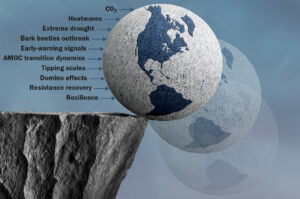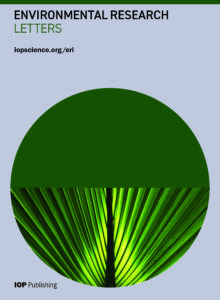ERL特刊精选|Focus on Earth System Resilience and Tipping Behavior

特刊详情
客座编辑
- Chuixiang Yi,美国纽约市立大学
- Vasilis Dakos,法国蒙彼利埃大学
- Manjana Milkoreit,挪威奥斯陆大学
- Courtney Quinn,澳大利亚联邦科学与工业研究组织
- Paul Ritchie,英国埃克塞特大学
- Juan Rocha Gordo,瑞典斯德哥尔摩大学
- Jana Sillmann,挪威国际气候研究中心
主题范围

特刊文章
Editorial
Earth system resilience and tipping behavior
Chuixiang Yi et al 2024 Environ. Res. Lett. 19 070201
Letters
Hye-Ryeom Kim et al 2023 Environ. Res. Lett. 18 074031
Joseph J Clarke et al 2023 Environ. Res. Lett. 18 035006
Typicality of the 2021 Western North America summer heatwave
Valerio Lucarini et al 2023 Environ. Res. Lett. 18 015004
Green Sahara tipping points in transient climate model simulations of the Holocene
Peter O Hopcroft and Paul J Valdes 2022 Environ. Res. Lett. 17 085001
Kerstin Lux et al 2022 Environ. Res. Lett. 17 075002
A compound event-oriented framework to tropical fire risk assessment in a changing climate
Andreia F S Ribeiro et al 2022 Environ. Res. Lett. 17 065015
Socio-metabolic risk and tipping points on islands
Simron J Singh et al 2022 Environ. Res. Lett. 17 065009
K J Allen et al 2022 Environ. Res. Lett. 17 055011
Ecosystems are showing symptoms of resilience loss
Juan C Rocha 2022 Environ. Res. Lett. 17 065013
The forest recovery path after drought dependence on forest type and stock volume
Hui Luo et al 2022 Environ. Res. Lett. 17 055006
A modeler’s guide to studying the resilience of social-technical-environmental systems
Lea A Tamberg et al 2022 Environ. Res. Lett. 17 055005
Contrasting responses of forest growth and carbon sequestration to heat and drought in the Alps
Ludovica Oddi et al 2022 Environ. Res. Lett. 17 045015
Sea ice-free corridors for large swell to reach Antarctic ice shelves
N J Teder et al 2022 Environ. Res. Lett.17 045026
Ecological resilience: what to measure and how
Vasilis Dakos and Sonia Kéfi 2022 Environ. Res. Lett. 17 043003
Joshua Prettyman et al 2022 Environ. Res. Lett. 17 035004
Colin Raymond et al 2022 Environ. Res. Lett. 17 035005
Satellite evidence of canopy-height dependence of forest drought resistance in southwestern China
Peipei Xu et al 2022 Environ. Res. Lett. 17 025005
Fragmented tipping in a spatially heterogeneous world
Robbin Bastiaansen et al 2022 Environ. Res. Lett. 17 045006
Christian L E Franzke et al 2022 Environ. Res. Lett. 17 015004
Tipping point dynamics in global land use
Charles A Taylor and James Rising 2021 Environ. Res. Lett.16 125012
What do we mean, ‘tipping cascade’?
Ann Kristin Klose et al 2021 Environ. Res. Lett. 16 125011
On the impossibility of extreme event thresholds in the absence of global warming
Noah S Diffenbaugh and Frances V Davenport 2021 Environ. Res. Lett. 16 115014
A prototype Earth system impact metric that accounts for cross-scale interactions
Steven J Lade et al 2021 Environ. Res. Lett. 16 115005
Matteo Zampieri et al 2021 Environ. Res. Lett. 16 105001
Topical reviews
I Hagen et al 2022 Environ. Res. Lett. 17 033002
Theoretical and paleoclimatic evidence for abrupt transitions in the Earth system
Niklas Boers et al 2022 Environ. Res. Lett.17 093006
期刊介绍

- 2023年影响因子:5.8 Citescore: 11.9
- Environmental Research Letters(ERL)以金色开放获取模式出版,作者可选择将原始数据作为补充资料与文章一起发表。所有研究人员可以免费获取这些研究成果。ERL汇聚了关注环境变化及其应对的研究团体和政策制定团体的意见,涵盖了环境科学的所有方面,出版研究快报、综述文章、观点和社论。ERL顺应了环境科学的跨学科发表的趋势,反映了该领域相关的方法、工具和评估战略,得到了来自不同领域的广泛贡献。
